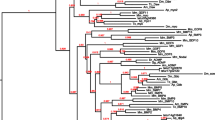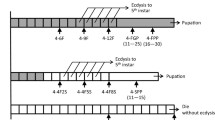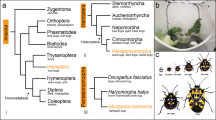Abstract
Activation of Ras signaling by the receptor tyrosine kinase Sevenless plays important roles during retinal patterning and male germline development in Drosophila. Sevenless is orthologous to the vertebrate receptor tyrosine kinase c-ros. Remarkably, vertebrate ligands of c-Ros as well as non-Drosophila orthologs of the Sevenless ligand Bride of sevenless have remained elusive. Using newly available insect genome sequence information, we investigated the evolutionary conservation of the seven transmembrane domain protein gene bride of sevenless. Single orthologs were identified in the genomes of mosquito, flour beetle, and honeybee due to strong sequence conservation in the seven transmembrane domain. The extracellular region, however, is only detectably conserved within but not outside Diptera. Analysis of domain-specific substitution rates demonstrates correlated fast rates of evolutionary change in the extracellular domains of both bride of sevenless and sevenless. The rapid pace of sequence change explains why Sevenless ligands are difficult to detect by sequence similarity in distantly related phyla. Second, the conservation of bride of sevenless in flour beetle and honeybee raises the possibility of conserved Sevenless signaling controlled patterning processes in endopterygote insects.

Similar content being viewed by others
References
Altschul SF, Madden TL, Schaffer AA, Zhang J, Zhang Z, Miller W, Lipman DJ (1997) Gapped BLAST and PSI-BLAST: a new generation of protein database search programs. Nucleic Acids Res 25(17):3389–3402
Avram CE, Cooper TG (2004) Development of the caput epididymidis studied by expressed proteins (a glutamate transporter, a lipocalin and beta-galactosidase) in the c-ros knockout and wild-type mice with prepubertally ligated efferent ducts. Cell Tissue Res 317(1):23–34
Banerjee U, Renfranz PJ, Hinton DR, Rabin BA, Benzer S (1987) The Sevenless protein is expressed apically in cell membranes of developing Drosophila retina; it is not restricted to cell R7. Cell 51(1):151–158
Birchmeier C, Birnbaum D, Waitches G, Fasano O, Wigler M (1986) Characterization of an activated human ros gene. Mol Cell Biol 6(9):3109–3116
Carroll SB, Grenier JK, Weatherbee SD (2006) From DNA to diversity. Blackwell Science Inc, Malden, Massachusetts
Castresana J (2000) Selection of conserved blocks from multiple alignments for their use in phylogenetic analysis. Mol Biol Evol 17(4):540–552
Chen JM, Heller D, Poon B, Kang L, Wang LH (1991) The proto-oncogene c-ros codes for a transmembrane tyrosine protein kinase sharing sequence and structural homology with sevenless protein of Drosophila melanogaster. Oncogene 6(2):257–264
Cooper MT, Bray SJ (2000) R7 photoreceptor specification requires Notch activity. Curr Biol 10(23):1507–1510
Felsenstein J (1986) Jackknife, bootstrap and other resampling methods in regression-analysis—discussion. Ann Stat 14:1304–1305
Felsenstein J (1995) PHYLIP (Phylogeny Inference Package) [Felsenstein, J. 1993. version 3.5c. Distributed by the author. Department of Genetics, University of Washington, Seattle.]. University of Washington, Seattle
Friedrich M, Rambold I, Melzer RR (1996) The early stages of ommatidial development in the flour beetle Tribolium castaneum (Coleoptera, Tenebrionidae). Dev Genes Evol 206:136–146
Friedrich M, Dong Y, Jackowska M (2006) Insect interordinal relationships: insights from the visual system. Arthropod Systematics & Phylogeny 64:133–148
Hafen E, Basler K, Edstroem JE, Rubin GM (1987) Sevenless, a cell-specific homeotic gene of Drosophila, encodes a putative transmembrane receptor with a tyrosine kinase domain. Science 236(4797):55–63
Hart AC, Kramer H, Van Vactor DL Jr, Paidhungat M, Zipursky SL (1990) Induction of cell fate in the Drosophila retina: the bride of sevenless protein is predicted to contain a large extracellular domain and seven transmembrane segments. Genes Dev 4(11):1835–1847
Honeybee Genome Sequencing Consortium (2006) Insights into social insects from the genome of the honeybee Apis mellifera. Nature 443(7114):931–949
Jones DT, Taylor WR, Thornton JM (1992) The rapid generation of mutation data matrices from protein sequences. Comput Appl Biosci 8(3):275–282
Kitadate Y, Shigenobu S, Arita K, Kobayashi S (2007) Boss/Sev signaling from germline to soma restricts germline-stem-cell-niche formation in the anterior region of Drosophila male gonads. Dev Cell 13(1):151–159
Kumar SK, Tamura K, Nei M (1993) MEGA: Molecular evolutionary genetics analysis. Version 1.01. Pennsylvania State University, University Park
Neckameyer WS, Wang LH (1985) Nucleotide sequence of avian sarcoma virus UR2 and comparison of its transforming gene with other members of the tyrosine protein kinase oncogene family. J Virol 53(3):879–884
Pires-daSilva A, Sommer RJ (2003) The evolution of signaling pathways in animal development. Nat Rev Genet 4:39–49
Ready DF (1989) A multifaceted approach to neural development. Trends Neurosci 12:102–110
Reinke R, Zipursky SL (1988) Cell–cell interaction in the Drosophila retina: the bride of sevenless gene is required in photoreceptor cell R8 for R7 cell development. Cell 55(2):321–330
Rubin GM (1991) Signal transduction and the fate of the R7 photoreceptor in Drosophila. Trends Genet 7(11–12):372–377
Saitou N, Nei M (1987) The neighbor-joining method: a new method for reconstructing phylogenetic trees. Mol Biol Evol 4(4):406–425
Schmidt HA, Strimmer K, Vingron M, von Haeseler A (2002) TREE-PUZZLE: maximum likelihood phylogenetic analysis using quartets and parallel computing. Bioinformatics (Oxford, England) 18(3):502–504
Sevrioukov EA, Walenta JH, Sunio A, Phistry M, Kramer H (1998) Oligomerization of the extracellular domain of Boss enhances its binding to the Sevenless receptor and its antagonistic effect on R7 induction. J Cell Sci 111(Pt 6):737–747
Shilo BZ (2003) Signaling by the Drosophila epidermal growth factor receptor pathway during development. Exp Cell Res 284(1):140–149
Sonnenberg E, Godecke A, Walter B, Bladt F, Birchmeier C (1991) Transient and locally restricted expression of the ros1 protooncogene during mouse development. EMBO J 10(12):3693–3702
Tarraga J, Medina I, Arbiza L, Huerta-Cepas J, Gabaldon T, Dopazo J, Dopazo H (2007) Phylemon: a suite of web tools for molecular evolution, phylogenetics and phylogenomics. Nucleic Acids Res 35(Web Server issue):W38–W42
Tessarollo L, Nagarajan L, Parada LF (1992) c-ros: the vertebrate homolog of the sevenless tyrosine kinase receptor is tightly regulated during organogenesis in mouse embryonic development. Development 115(1):11–20
Thompson JD, Higgins DG, Gibson TJ (1994) CLUSTAL W: improving the sensitivity of progressive multiple sequence alignment through sequence weighting, position-specific gap penalties and weight matrix choice. Nucleic Acids Res 22(22):4673–4680
Tomlinson A, Ready DF (1986) Sevenless—a cell-specific homeotic mutation of the Drosophila eye. Science 231:400–402
Tomlinson A, Struhl G (2001) Delta/Notch and Boss/Sevenless signals act combinatorially to specify the Drosophila R7 photoreceptor. Mol Cell 7(3):487–495
Yang ZH, Nielsen R (2000) Estimating synonymous and nonsynonymous substitution rates under realistic evolutionary models. Mol Biol Evol 17(1):32–43
Yeung CH, Wagenfeld A, Nieschlag E, Cooper TG (2000) The cause of infertility of male c-ros tyrosine kinase receptor knockout mice. Biol Reprod 63(2):612–618
Acknowledgments
We are grateful to Hugh Robertson for valuable discussion and two anonymous reviewers for useful suggestions.
Author information
Authors and Affiliations
Corresponding author
Additional information
Communicated by S. Roth
Electronic supplementary material
Below is the link to the electronic supplementary material.
Supplementary file 1
Multiple alignment of all boss orthologs in Gblocks and FASTA format (DOC 99 kb)
Supplementary file 2
Multiple alignment of all boss-related 7TM domain sequences in Gblocks and FASTA format (DOC 115 kb)
Supplementary file 3
Pairwise alignment of Drosophila melanogaster and Drosophila pseudoobscura boss in Gblocks and FASTA format (DOC 52 kb)
Supplementary file 4
Multiple alignment of boss from Drosophila melanogaster, Drosophila pseudoobscura, Drosophila virilis, and Aedes aegypti in Gblocks and FASTA format (DOC 76 kb)
Supplementary file 5
Pairwise alignment of Drosophila melanogaster and Drosophila pseudoobscura sev in Gblocks and FASTA format (DOC 112 kb)
Supplementary file 6
Multiple alignment of sev from Drosophila melanogaster, Drosophila pseudoobscura, Drosophila virilis, and Aedes aegypti in Gblocks and FASTA format (DOC 160 kb)
Supplementary file 7
Pairwise alignment of Drosophila melanogaster and Drosophila pseudoobscura Egfr in Gblocks and FASTA format (DOC 79 kb)
Supplementary file 8
Multiple alignment of Egfr from Drosophila melanogaster, Drosophila pseudoobscura, Drosophila virilis, and Aedes aegypti in Gblocks and FASTA format (DOC 119 kb)
Supplementary file 9
Excel spreadsheet with accession numbers of boss, sev, and Egfr gene models from Drosophila melanogaster, Drosophila pseudoobscura, Drosophila virilis, Aedes aegypti, Tribolium castaneum, and Apis mellifera used in this study (XLS 17 kb)
Rights and permissions
About this article
Cite this article
Bao, R., Friedrich, M. Fast co-evolution of sevenless and bride of sevenless in endopterygote insects. Dev Genes Evol 218, 215–220 (2008). https://doi.org/10.1007/s00427-007-0201-0
Received:
Accepted:
Published:
Issue Date:
DOI: https://doi.org/10.1007/s00427-007-0201-0




